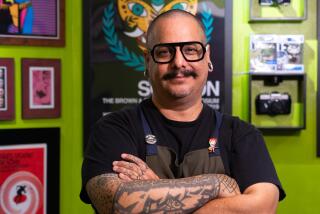‘I Get Bored When I See Comics Where the [Artist] Just Sent It In’ : BY JAMES McCAFFREY
Illustrator Chris Bachalo has just signed a two-year exclusive contract with Marvel Comics to continue drawing “Generation X,” the hyperkinetic spinoff title of the long-running “X-Men” series. In addition, a live-action TV movie--also titled “Generation X”--based on the comic-book characters he created with writer Scott Lobdell premieres Tuesday night at 8 on the Fox network (Related story, F2). Not bad for a guy from Winnipeg, Manitoba, who only five years ago was surviving by painting ceramic pots in a warehouse.
“It was cruddy work . . . cold, with lots of clay dust,” the 30-year-old resident of Dove Canyon, east of Mission Viejo, recalled during a recent interview over lunch at the California Pizza Kitchen in Laguna Hills. “I had to lift pots all day and my back hurt, but it was good experience because I had to do it fast to earn any money.”
Far removed from those days, Bachalo took a break from illustrating to discuss how he moved from painting pots to comic books, and his approach to the books he works on.
*
Question: What were your first experiences with comics?
*
Answer: I started reading comics when I was 10. My dad was a beekeeper, and every summer my family [who moved to Fountain Valley shortly after Chris’ birth] would drive to Canada, where my dad would farm bees. The drive would take about three days. One year on the way back--I was about 10--we were in a drugstore getting ready to leave. My mom was looking for stuff to keep us busy, and I stopped by the comic rack. I hadn’t seen comics before. I was very interested in monsters, dinosaurs, that kind of stuff. I looked at the one that had Swamp Thing fighting a dinosaur on the cover. . . . I collected [comic books] for the next five years or so.
Q: That would put you in high school. Is that where you got serious about drawing?
A: Yes. I liked drawing, and I was always interested in art, but didn’t draw much. The turning point was my high-school Career Days experience. I filled out all the forms and bubbles, and it was deduced that I would be well-suited to carpentry work. I thought, “No, that’s not what I want to do!” and started drawing every day. I was drawing with felt-tip pens and notebook paper--nothing fancy. . . . I picked up classes during my last two years in high school. I learned all the basics, like how to define shapes using shading and rendering and square blocks and drawing the human head and learning how to use color.
Q: Did your enthusiasm spill over to college?
A: I went to Cal State Long Beach and acquired a degree in illustration [in 1989]. I didn’t get much positive feedback about doing comics. During my last semester, I rounded out my portfolio by drawing my own comic book. I just sat down and said, “This is what I’m going to pursue.” It was that rudimentary.
Q: Lots of aspiring artists dream about this kind of work. How did you make it happen?
A: I sent out about 50 copies of my book and got rejected by everyone [including DC Comics]. One company even sent me a photocopied textbook about how to draw. It stung a little, but I knew that I needed more practice. In the meantime, I worked a real job. It was while I was painting ceramic pots for $8 an hour that my dad took it upon himself to arrange an interview for me with a real estate company. I met their art director, Helen Woo, [who is now Bachalo’s wife] and was hired. Shortly thereafter, DC Comics contacted me and asked if I had been working on anything more recently.
Q: Your reaction?
A: I sent DC Comics this work that I had just finished drawing and penciling. About a week later, the art director [Richard Bruning] gave me a call and asked me if I wanted to try out for a book called “Shade.” I said sure. . . . While “Shade” was being developed, I filled in on an [another DC Comics] book called “Sandman,” by Neil Gaiman, Issue 12. That was my first work, and I went on from there. I worked on “Shade” for the next four years.
Q: How did you get involved with “Generation X”?
A: The funny thing about how this all worked out is the timing. All of the popular artists at Marvel had left [to form Image Comics], and Marvel had a lot of abandoned titles. I was asked to do a fill-in issue [Number 400] for “The Incredible Hulk,” which floored me. I had never worked on a superhero book before. [After that,] my name started getting mentioned in the Marvel offices, I guess, [and] I was asked to do “X-Men Unlimited” Number 1. I turned it down. When I returned home, my wife told me otherwise. She knew what the X-men were about, and more importantly, she told me that it was in my best interest financially. I called them back to accept the offer the next day. That book was my first work with Scott Lobdell, [co-creator of “Generation X”]. He liked my work and told me about “Gen-X,” which was then-untitled.
The problem was that I still had almost a year left on my contract for “Shade.” Scott told me that they were still in the planning stages and would wait. At the San Diego ComicCon [convention], Scott and I started discussing the characters. This was my first serious plunge into the superhero genre, so I had my doubts. “Shade” was a dark and eccentric book, and this new thing ran the risk of being more . . . conservative.
Q: What convinced you to do “Generation X”?
A: I knew I was in good shape as soon as Scott gave me his ideas, which were very weird. He envisioned this character [Chamber] who had his face and chest blown off by an internal explosion. I thought, “Whoa! That’s a little different!” I had him scribble me a rough idea of what he wanted. I took it home and thought about it. When I put it on paper, I knew that the character would work, and I wanted to do more.
Q: What age groups does “Generation X” target?
A: As many as possible! I understand that “X-Men” generally caters to kids between 10 and 14, but we seem to reach people a lot older than that. . . I think we please readers who are only interested in the stories, and also those readers who want to see things happening, both visually and verbally, beneath the surface.
Q: Who are some of your favorite characters and artists from other books?
A: I have to go back to my childhood interest in monsters. I loved werewolf characters, especially Deathlok the Demolisher. If I could pick one character to develop, it’s him. He has so much unused potential it’s ridiculous. As for artists, two in particular were inspirational. Michael Golden drew “Micronauts,” which I thought was the greatest thing in the world. He did the “Dr. Strange” issue [Number 55], which is like my bible. The other is Bill Sienkiewicz. . . . He did “Moon Knight,” among other things. He really explored the narrative possibilities of the art form, and his work is fantastic.
Q: A common observation about your work is that you don’t waste space. When did you start hiding objects in the background?
A: Since the first issue of “Shade,” I’ve tried to make the books interesting to look at. I get bored when I see comics where the [artist] just sent it in. Lots of guys don’t put real thought into their work, and it shows! . . . I enjoy throwing a turtle in, with the issue number and a little racing stripe on the shell. In issue Number 17, I have Gamera [an old monster-movie turtle] flying by. In the same issue, Stan Lee [co-creator of the “X-Men”] appears as himself and wrote all of his own dialogue. Little stuff like that makes this job a blast.
* “Generation X,” a new movie based on the comic strip, airs Tuesday at 8 p.m. on the Fox Network. On Saturday from 4-7 p.m., Chris Bachalo will sign his work at the Collector’s Library, 2930 Bristol St., A112 (in the Lab), Costa Mesa. (714) 545-1216.
More to Read
The biggest entertainment stories
Get our big stories about Hollywood, film, television, music, arts, culture and more right in your inbox as soon as they publish.
You may occasionally receive promotional content from the Los Angeles Times.










